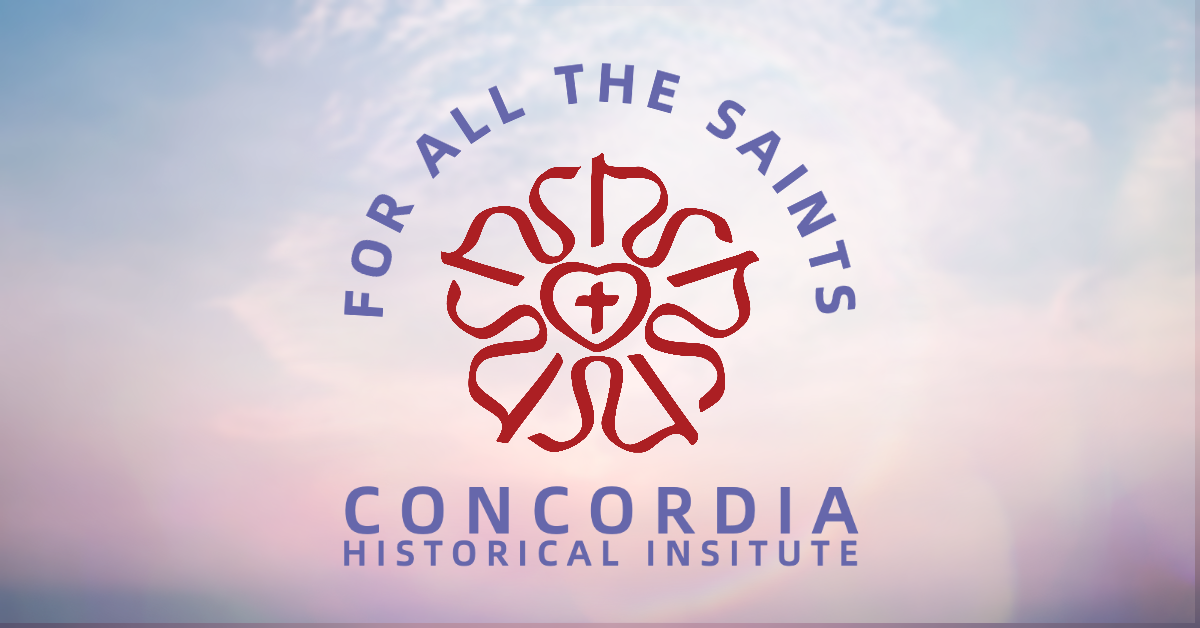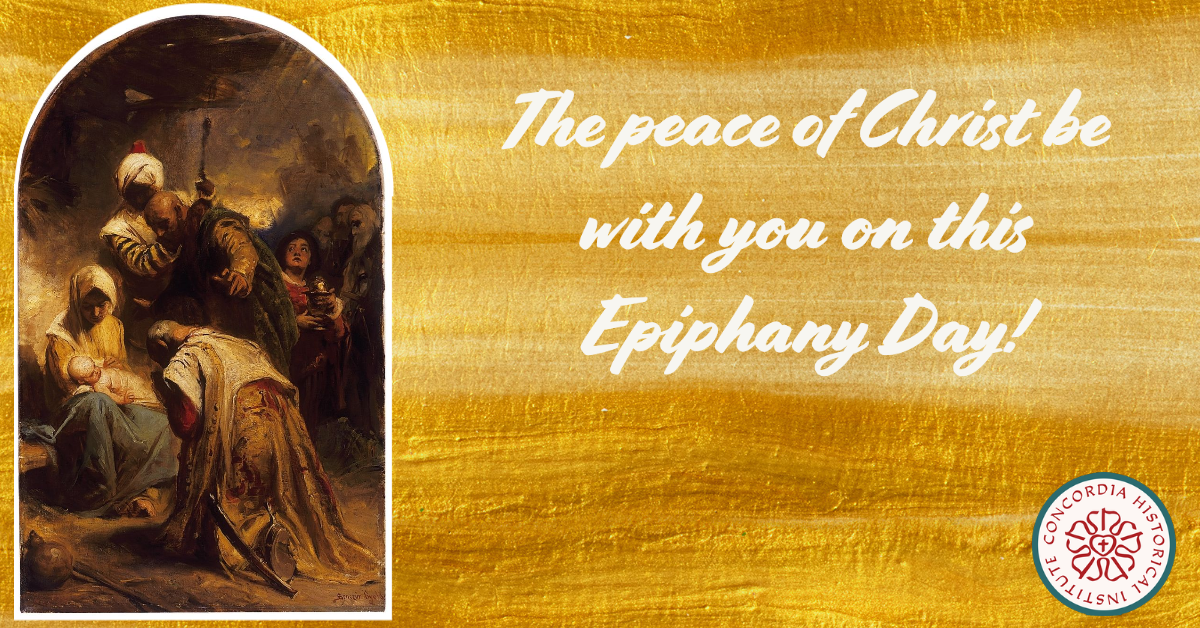For All the Saints 2022: 12 Days of Christmas
The Real Story of the Twelve Days of Christmas
An Invitation to Give
The Real Story of the Twelve Days of Christmas
For our final week of our end-of-year giving campaign, we would like to do something a little different. This week, we offer you a brief series on the history and meaning of the Twelve Days of Christmas. We hope you enjoy and learn from this series, and may God bless and keep you during this Christmastide!
Christmastide, or, The Twelve Days of Christmas
“On the first day of Christmas, my true love gave to me
A partridge in a pear tree…”
And so on and so on. We all know the Christmas song, but what—if anything—does it mean?
Recently, some have proposed theories that the lyrics to “The Twelve Days of Christmas” contain highly-coded symbols relating to theological doctrines or other important concepts for Christians. Fun as this would be, it is almost certainly untrue. There is little evidence to support this claim. Instead, the more widely-accepted theory is that the song arose as a children’s memory game.
But, there is a real Twelve Days of Christmas. The twelve days between the end of Advent, the season of preparation leading up to Christmas, and Epiphany, the arrival of the wise men or Magi to adore the Christ child, are known as Christmastide. (The ending “-tide” means period or season.) In a day and age when the “Christmas season” seemingly stretches from early November until December 25th and not a millisecond later, it can be exceptionally helpful to return to the traditional rhythms of the church’s calendar, with its emphasis on setting aside a period to linger and dwell on the miracle of Christ coming to us. With the hustle and bustle—not to mention holiday blues—that so many now associate with secular and commercialized Christmas obligations, this can be a peace-bringing and freeing tradition to bring into your life.
For More Information
The Lutheran Church—Missouri Synod has no set sequence of feasts and commemorations for all twelve of the days in Christmastide. In fact, there is no historical set of 12 unique days of festivities during the Christmas season. There are, however, a number of holidays commemorating ancient and modern Christians that fall during this period.
Many of the days do have set festivals and remembrances that appear on the official LCMS liturgical calendar, however, many do not. Not all of the commemorations listed below are celebrated within the Lutheran church, as many of the individuals were neither biblical figures, early church figures, nor Lutherans, the three types of people recognized in our liturgical commemorations. However, the histories and stories of all of these Christians should prove educational and uplifting, regardless. For more resources on commemorations within the LCMS, please see the official LCMS Worship Resources page or Rev. William Weedon’s book, Celebrating the Saints (Saint Louis: Concordia Publishing House, 2016).
The Nativity of Our Lord: December 25
 The Twelve Days of Christmas begin with, well, Christmas! The official liturgical name for this festival is The Feast of the Nativity of Our Lord. The word “Christmas” comes from a shortened form of Christ’s Mass, or the mass (divine service) celebrated in honor of Christ.
The Twelve Days of Christmas begin with, well, Christmas! The official liturgical name for this festival is The Feast of the Nativity of Our Lord. The word “Christmas” comes from a shortened form of Christ’s Mass, or the mass (divine service) celebrated in honor of Christ.
The first recorded celebration of Christmas occured on December 25th, 336, in Rome. December 25th, the winter solstice in the Roman calendar, was chosen as the date because tradition holds that Jesus was conceived in the womb of the Virgin Mary on March 25th, nine months earlier. (You may also notice that this date is close to Easter—medieval Christians also believed that Jesus was crucified on March 25th.)
Christmas Day opens up the season of Christmas, rather than, as according to our modern secular calendar, more or less ending it. We hope you enjoy spending the next twelve days meditating on Christ’s redemptive love for the world shown at His Incarnation and Nativity, as well as shown in the lives of the Christian saints whom we remember during this season.
Saint Stephen, Martyr: December 26

Luis de Morales, Saint Stephen. Source
On December 26th, the second day of Christmas, the church celebrates Saint Stephen, the first martyr.
Stephen was a deacon of the early church who appears in the book of Acts. Stephen was chosen to serve as deacon in Acts 6:5, in order to perform the acts of mercy and charity of the church so as to allow the pastors more time to preach and teach. Shortly thereafter, the leadership of the synagogue seized Stephen on account of his prolific witness and miraculous acts (6:8–15). Before the council, Stephen gave a strong and courageous defense of his faith. The council, deeply scandalized by the message of Christ, rose up to stone him. Acts 7:54–60 recounts his death:
Now when they heard these things they were enraged, and they ground their teeth at him. But he, full of the Holy Spirit, gazed into heaven and saw the glory of God, and Jesus standing at the right hand of God. And he said, “Behold, I see the heavens opened, and the Son of Man standing at the right hand of God.” But they cried out with a loud voice and stopped their ears and rushed together at him. Then they cast him out of the city and stoned him. And the witnesses laid down their garments at the feet of a young man named Saul. And as they were stoning Stephen, he called out, “Lord Jesus, receive my spirit.” And falling to his knees he cried out with a loud voice, “Lord, do not hold this sin against them.” And when he had said this, he fell asleep.
Why do we remember this grim moment during the Christmas season? Traditionally, Christians have believed that Stephen died on this date. (Most feast and commemoration days fall on the date of the person’s death.) Nor is Stephen the only martyr commemorated during this season. Remembering these Christians who died for the faith serves to comfort us in our own sufferings. As the reformer Urbanus Rhegius said, “Are not the saints the brightest mirrors of divine grace in which we see what the grace of God can do?” (quoted in William Weedon, Celebrating the Saints [Saint Louis: Concordia Publishing House, 2016], 7).
St. Stephen’s Day also falls on Boxing Day, a traditional day of charity to the poor in Great Britain. The “box” may refer to the church alm’s box, which the church opened on that day for distribution. It could also be a box of food, money, and gifts given by employers to their servants to take home to their families—servants would have had to work on Christmas Day, but were given the 26th as a day of rest.
Saint John, Apostle and Evangelist: December 27

Michaelina Wautier, John the Evangelist. Source
On the third day of Christmas, December 27th, the church celebrates Saint John, apostle and evangelist.
Saint John, “the disciple whom Jesus loved,” was one of the twelve apostles and the author of the Gospel of John, the epistles 1, 2, and 3 John, and Revelation. John was the younger brother of James the Great, son of Zebedee. In fact, John was the youngest of Jesus’s disciples. John also was the only disciple present at the crucifixion. Jesus entrusts Mary, His mother, to the care of John from the cross. Church artwork generally depicts the Virgin Mary (dressed in blue) with John, a young man, along with others (including Mary Magdalene, Mary of Clopas, Salome, etc.) weeping at the foot of the cross.
According to tradition, Saint John is the only apostle who was not martyred. The early church held that John was exiled to Patmos, where he wrote the Book of Revelation. Tradition also states that John taught Polycarp, bishop of Smyrna, and and Ignatius of Antioch.
John is frequently depicted in church art with an eagle—one of the four living creatures in Revelation that is generally interpreted as representing the four evangelists. John corresponds to the eagle because of the soaring and beautiful nature of his writing. Additionally, John sometimes holds a cup or chalice, often with a snake or dragon(!) inside. This comes from an extra-biblical story about John drinking poison without being harmed (in fulfilment of Mark 16:18).
The Holy Innocents, Martyrs: December 28

Pieter Brueghel, Massacre of the Innocents. Source
The church remembers the Holy Innocents, Martyrs, on December 28th, the fourth day of Christmas.
The Feast of the Holy Innocents, also called Childermas (from a shortened form of “Children’s Mass”), is the day the church around the world has set aside to commemorate the Massacre of the Innocents:
Then Herod, when he saw that he had been tricked by the wise men, became furious, and he sent and killed all the male children in Bethlehem and in all that region who were two years old or under, according to the time that he had ascertained from the wise men. Then was fulfilled what was spoken by the prophet Jeremiah:
“A voice was heard in Ramah,
weeping and loud lamentation,
Rachel weeping for her children;
she refused to be comforted, because they are no more.”(Matthew 2:16–18)
Because of the murderous rage of Herod, Mary and Joseph fled with the infant Christ to Egypt.
The Massacre of the Innocents is perhaps the most challenging feast day during the Christmas season for us today. In many ways, this violent and terrifying moment in the Bible is very foreign from what we most of us in the modern West have experienced. And yet, it is also all too familiar: this date on the liturgical calendar certainly brings to mind the grim reality of abortion in the United States.
In addition to reminding us of the horrifying reality of human cruelty and sin, the day points us to the suffering endured by Christ (and, by extension, all Christians—see John 15:20). While the little boys that Herod killed died for the sake of Jesus, Jesus would live in order to die for them. The church commemorates these infants as martyrs who are likewise comforted in the arms of their loving Savior and who will likewise experience the resurrection and restoration of all the faithful.
David: December 29

Close-up of Michelangelo’s David. Source
The Western church recognizes David, king and prophet, on December 29th, the fifth day of Christmas.
Oftentimes we tend to overlook Old Testament feast days, especially David’s in the middle of the Christmas season. Nevertheless, it’s an important time to remember this significant prophet, king, and forefather of Jesus.
David was chosen by God to be king of Israel after the failure of King Saul. From Samuel’s anointing of David to David’s conquest of Goliath to his trials and tribulations recorded in his psalms, in many ways David’s life was a foreshadowing type of Jesus, the messiah promised to come to save David and all mankind.
David, of course, is also known for his great and public sin: his adultery with Bathsheba and subsequent murder-by-military-order of her husband, Uriah the Hittite, to cover up his deed. With this story, which we so strongly associate with the boy-shepherd-turned-king, it can be hard to think of David as a “saint.” And yet, God used this fallen man not only to shepherd Israel during his life, but also to bring about a greater King, Jesus, through his lineage. David is a profound reminder that our God works through the means of history—even the history of fallen men and women like us—to bring about the salvation of the world.
The Holy Family: December 30

Fritz von Uhde, Holy Night. Source
Some churches celebrate the Feast of the Holy Family on December 30, the sixth day of Christmas.
The Feast of the Holy Family (Jesus, Mary, and Joseph) was a locally celebrated feast dating back to the 17th century that became a part of the Roman Catholic liturgical calendar in 1921. As such it is primarily a Roman Catholic observance, though some Lutheran and Anglican churches also recognize it. This feast day is not recognized on the LCMS liturgical calendar. However, Lutherans have great respect for the Virgin Mary and Joseph, guardian of Jesus, and have stressed the importance of Christ’s sinless childhood and youth as part of His incarnation.
The point of popularizing this festival was to present Christian families with a positive role model in the Holy Family. As Christians, we can look to Saints Mary and Joseph—our sister and brother in Christ—as models of faith and faithfulness in vocation. Our evangelical heritage prizes the historic saints as examples for encouragement and inspiration, and the Holy Family is no exception. Further, it can be beneficial to contemplate the awesome might of the Second Person of the Trinity, the Divine Logos, incarnated into the humble and helpless form of a tiny baby, a growing toddler, and a reverent boy through reading the Gospel accounts of Jesus’s childhood. For Jesus was true man, meaning He was born a true baby who grew and experience a true childhood. What a mystery to behold this and every day!
St. Sylvester Night: December 31

Anonymous, Pope Saint Sylvester I. Source
On December 31st, the seventh day of Christmas, the church has historically celebrated St. Sylvester Day.
Pope Sylvester I (285–31 December 335) was the 33rd pope, serving from 314–335, one of the longest papal reigns in history. During his time as pope, several large churches were built. The Council of Nicea took place while Sylvester was pope, though he did not personally attend.
The most significant part of Sylvester’s legacy is apocryphal. Legend says that Sylvester baptized Constantine, which simultaneously cured the emperor of leprosy. Constantine was exceptionally grateful for Sylvester’s pastoral care and, according to tradition, gave up his imperial insignia and crown and put himself under the pope’s authority. The counterfeit Donation of Constantine purported to be documentation of this mythical event. In it, Constantine recounts his conversion and the status granted to Sylvester and all successive bishops of Rome as supreme pontiff, with power over both ecclesiastical and secular activities.
There is an interesting Reformation connection with Sylvester via the Donation of Constantine. The Italian priest and humanist Lorenzo Valla (1407–1457) was able to disprove the document’s authenticity. The document uses Latin vocabulary that did not exist at the time of its supposed creation, and instead probably dates from the 8th century, some 400 years later. The rejection of this document seriously undermined papal claims to secular authority and property. It also raised questions about the historical role of the pope in late antiquity. Luther and other reformers would build on the work of Valla and other humanists in the course of the Reformation.
Though much of Sylvester’s legacy is fabricated, we can still give thanks to God for using wise leaders to sustain his church throughout history.
Circumcision and Name of Jesus: January 1
The Feast of the Circumcision and Name of Jesus falls on January 1st, the eighth day of Christmas.

Rembrandt van Rijn, The Circumcision. Source
This feast day is another one that strikes the modern world as odd. With its placement on New Year’s Day, the secular holiday (and the activities of the previous night) often overshadows it. Besides, why does the church dedicate an entire festival to Jesus’s circumcision?
The circumcision of Jesus was the first time Christ shed His blood for us. Jesus fulfilled this aspect of the Old Testament covenant, followed by Israel since the days of Abraham, for our sake. The Lord of Life submitted Himself to every iota of God’s Law and kept it perfectly, because we could not.
Like Jesus’s baptism, Jesus’s circumcision is for us. It also foreshadows the physical suffering which our Savior would experience throughout His earthly ministry. Even as an eight-day-old baby, the sinless Messiah is already bearing the consequences of our sinfulness in His body. Jesus would continue to experience physical anguish for us, culminating in His crucifixion and death on our behalf.
On this Feast of the Circumcision and Naming of Our Lord, let us give thanks to God for His Son, “Christ Jesus, who, though he was in the form of God, did not count equality with God a thing to be grasped, but emptied himself, by taking the form of a servant, being born in the likeness of men” (Philippians 2:5–6), even unto circumcision.
J. K. Wilhelm Loehe: January 2

J. K. Wilhelm Loehe. Source
The Lutheran Church—Missouri Synod commemorates J. K. Wilhelm Loehe on January 2nd, the ninth day of Christmas.
Many churches around the world recognize Saints Basil the Great and Gregory of Nazianzus today. The calendar of commemorations for the Lutheran Church—Missouri Synod lists Basil and Gregory, along with Gregory of Nyssa, on January 10. The LCMS celebrates Loehe today, however, because of his significant role in the life of our denomination.
Johann Konrad Wilhelm Loehe (also spelled Löhe) was born on 21 February 1808 in the German state of Middle Franconia. He studied theology at the University of Erlangen, where he converted to Lutheranism, and received his first pastoral assignment to Bavaria in 1831, eventually settling in the town of Neuendettelsau in 1837.
Loehe was passionate about reclaiming a firm understanding of the Lutheran Confessions among the laity, and he was a strong proponent of liturgical reform. Further, he was a vocal proponent of social reform and mercy work. He was crucial in both the early days of the Missouri Synod and the deaconess movement. Loehe sent many pastors to the United States who helped found the Missouri Synod, and he also encouraged Lutheran pastors to go to Australia, Brazil, New Guinea, and Ukraine. Loehe founded the modern deaconess movement, initially as a way to provide safety and employment for unmarried young women. The women lived in a spiritual community called a “mother house” and did mercy work in the surrounding area.
God worked through Wilhelm Loehe to grow and sustain His church on five continents! Thanks be to God for the life and work of Wilhelm Loehe, and may the Lord of the harvest stir up similar zeal in us all.
The Name of Jesus: January 3
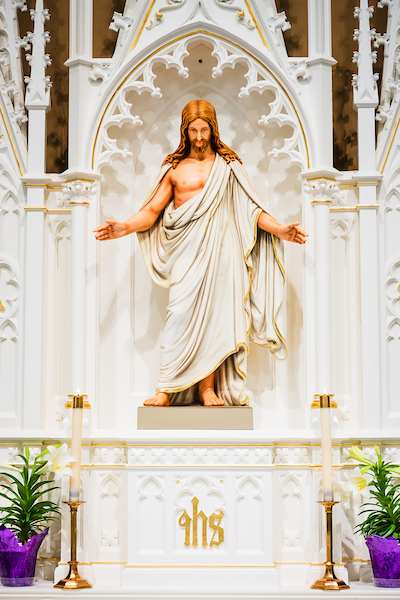
Easter lilies and the reredos with the statue depicting Jesus Christ on Monday, April 5, 2021, at Immanuel Lutheran Church, Washington, Mo. LCMS Communications/Erik M. Lunsford © 2021 The Lutheran Church—Missouri Synod. Image Source.
On January 3rd, the tenth day of Christmas, many churches celebrate the Name of Jesus.
Wait—didn’t we celebrate the name of Jesus on January 1st, during the feast day commemorating Jesus’s circumcision and naming? Yes. However, at various times in church history, the circumcision and naming of Jesus were celebrated on seperate days, despite occurring simultaneously in the actual life of Christ. However, this gives us an opportunity to address an important (and often misunderstood!) topic: the Christogram IHS.
Many people think that the monogram IHS is actually an acronym for “In His Service.” It isn’t. Some also think that it is a specifically Roman Catholic symbol. While IHS is used as the symbol of the Roman Catholic religious order the Society of Jesus (the Jesuits), there is nothing specifically Catholic or Jesuit about this symbol.
So what does IHS actually mean? IHS are the Latinized forms of the first three letters of Jesus’s name in Greek: ΙΗΣΟΥΣ. Iota-eta-sigma become I-H-S. This Christogram—similar to the Chi-Rho (XP) and other like monograms—appears frequently on altarpieces, liturgical vestments, and even the ever-popular and seasonally-relevant Chrismon ornaments.
The church across time has shown great reverence for the name of Jesus. Jesus is the fulfillment of the promise of His name, which means “YHWH saves.” And so, even though we have already celebrating the naming of Jesus earlier this Christmastide, it is never amiss to dwell on the name at which every knee shall bow and tongue confess (Philippians 2:10–11), Jesus, our salvation.
Elizabeth Ann Seton: January 4
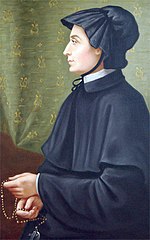
Portrait of Elizabeth Ann Seton by Amabilia Filicchi. Source
The Roman Catholic church recognizes Elizabeth Ann Seton on January 4th, the eleventh day of Christmas.
There is no January 4th feast day within the LCMS. There are a few within the Roman Catholic Church, most notably Elizabeth Ann Seton. Seton was born in colonial New York on August 28, 1774. In 1794 at age 19, Elizabeth Ann married William Magee Seton, a wealthy businessman. Her husband, an ill man, died in 1803 after only nine years of marriage. It was after his that Seton, raised Episcopalian, converted to Catholicism in 1805.
To support herself and her five children, Seton had started a girl’s school. However, after her conversion became public, most parents pulled their daughters out of her school, resulting in serious financial strain for the Seton family. It was not until 1809, when she moved to Emmitsburg, Maryland, that she founded Saint Joseph’s Academy and Free School for girls and experience greater success and financial security. Later, she would expand this into a religious community dedicated to caring for poor children. She died on January 4, 1821, at the age of 46. Pope Paul VI canonized Elizabeth Ann Seton as a saint within the Roman Catholic Church in 1975, the first American to receive such a designation.
Elizabeth Ann Seton is considered to be the founder of the American parochial school system. It was because of the work of people like Elizabeth Ann Seton that Missouri Synod Lutherans were able to found their own parochial schools in America. In many of the early (and contemporary!) legal battles and other difficulties facing parochial schools, our Roman Catholic brothers and sisters have been faithful allies in defending the right to freedom of religion and freedom to education in that religion.
Twelfth Night: January 5
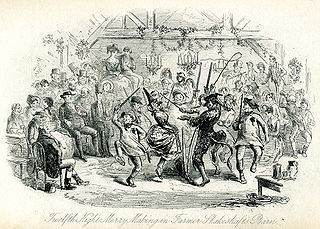
“Twelfth Night Merry-Making in Farmer Shakeshaft’s Barn”, from Ainsworth’s Mervyn Clitheroe, by Phiz. Source
The church celebrates Twelfth Night on January 5th, the twelfth and final day of Christmas.
Perhaps you know about Twelfth Night from the Shakespeare play of the same name. Twelfth Night was an English holiday that involved revelry and costumes, similar to Mardi Gras or Shrove Tuesday. Because Advent is a penitential season and Christmas a joyous and festive one, the end of Christmastide functioned as more-or-less the climax of the season.
Different churches and regions have different traditions for celebrating Twelfth Night. Generally people attended church services on the Eve of the Epiphany. Traditionally, beginning celebrations the night before an event was common. Consider Christmas Eve, New Year’s Eve, and even Easter Vigil, or the ongoing custom in Germany of having a birthday party the evening before one’s actual birthdate.
Other cultural customs also took root. The King’s Cake, for example, is a traditional Twelfth Night dessert. This cake and its variants, popular across Europe and Latin America, typically includes a small figurine of the infant Jesus. The person who finds the doll in his or her slice is the winner. House blessings and house chalkings are also common occurrences for this day, especially in Eastern churches. Door chalking consists of chalking a series of numbers of letters commemorating the current year and the three Magi (traditionally held to be named Caspar, Melchior, and Balthasar) on one’s door. This year, for example, one would chalk “20 † C † M † B † 23” over the door lintel.
Other traditions include drinking wassail (hot spiced wine punch) and wassailing (caroling, often in costume) in England. Additionally, this was often the day Christmas decorations were taken down in preparation for Epiphany.
The Epiphany of Our Lord: January 6
The Christmas season comes to an end on Epiphany, January 6th.
Epiphany celebrates the day that the Magi or wise men came to adore Jesus. Art often depicts three Magi, as with the hymn “We Three Kings.” The Bible does not actually specify the number, though this is likely drawn from the number of gifts, which was three: gold, frankincense, and myrrh.
It is also not entirely clear when they visited, although it was not on the night Jesus was born. Matthew 2:11 indicates that they found Jesus in a “house,” meaning the Holy Family had secured more permanent housing. Additionally, Herod’s injunction to kill all boys “two years old or under” (Matthew 2:16) does not give a very precise indication of how much time has passed between the Nativity and the Epiphany. Because of the close proximity of these events according to the church liturgical calendar, it is not unusual to have nativity scenes, hymns, and other artwork synthesizing these separate events into one single scene, especially for devotional purposes.
The gifts of the Magi are also significant. All three of these gifts were typical for royalty. Gold, frankincense, and myrrh were all extremely expensive in the ancient world and indicated very high status and power. There is more than just their material value, however. Since the early church, theologians have interpreted these gifts as confessing Christ’s incarnation and future passion. Gold is perhaps the most obvious gift: wealth. Myrrh is a sweet-smelling gum resin that was used in burial. Incense was part of the worship service. Origen wrote “gold, as to a king; myrrh, as to one who was mortal; and incense, as to a God.” The hymn “We Three Kings” echoes this: “Glorious now behold Him arise/King and God and sacrifice.”
Good News to the Gentiles
Epiphany also is the proclamation of the Good News to the Gentiles. Consider what Rev. Will Weedon writes in his book Celebrating the Saints:
The Church rejoices on Epiphany at the way God threw open the door of His grace to Gentiles, to non-Jews, as the Magi are traditionally regarded. For the Christ Child is King of all people, not just God’s ancient people! He is God come in the flesh to battle the enemies of the entire human race. The sacrifice He will offer is in exchange for every human. When the Magi kneel before Him in worship, they are but the very first of countless non-Jews who will fall before Him century after century.
Did they have the experience so many have had in all those years? That while they offered Him gifts, the feeling that the gift exchange was all backward? He had come to offer them and us the true and lasting gifts: His embrace, His welcome, His forgiveness and love. Here is the light that shines more brightly than the miraculous star. Here is the light of divine love shining from the face of Mary’s Son.
(Will Weedon, Celebrating the Saints [Saint Louis: Concordia Publishing House, 2016], 15).
We join the Magi in worshiping Jesus, Savior to the nations come, for us and all the world.
An Invitation to Give
We hope that you have enjoyed these devotionals, as well as our previous weeks’ historical content! At Concordia historical Institute, we hope to provide edifying and educational content that will enrich your understanding of our history as Missouri Synod Lutherans. We would like to thank all of our wonderful donors who have joined us on our mission of moving Lutheran history forward and generously given of their time, treasure, and talent to further CHI in its ministry of remembrance.
If you haven’t already, please consider joining CHI with a one-time, year-end, tax-deductible donation or as a member today! Additionally, Concordia Historical Institute is happy to assist with memorial gifts, special funds, and estate planning. For more information on these or any other giving opportunities, please contact us.


